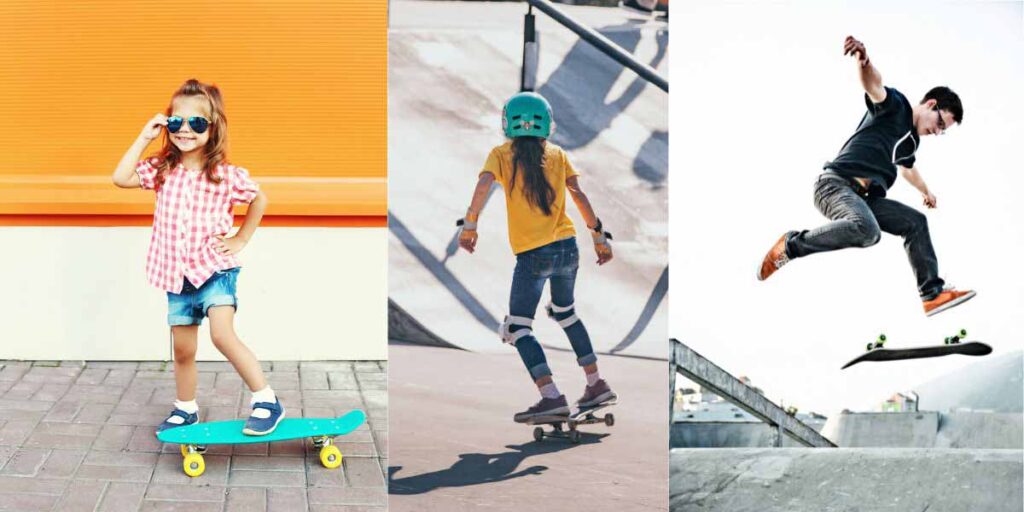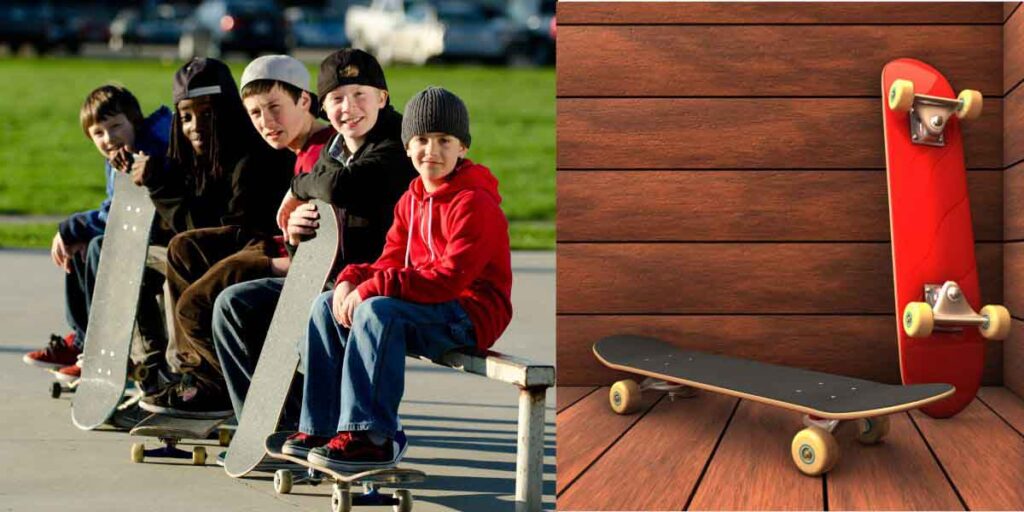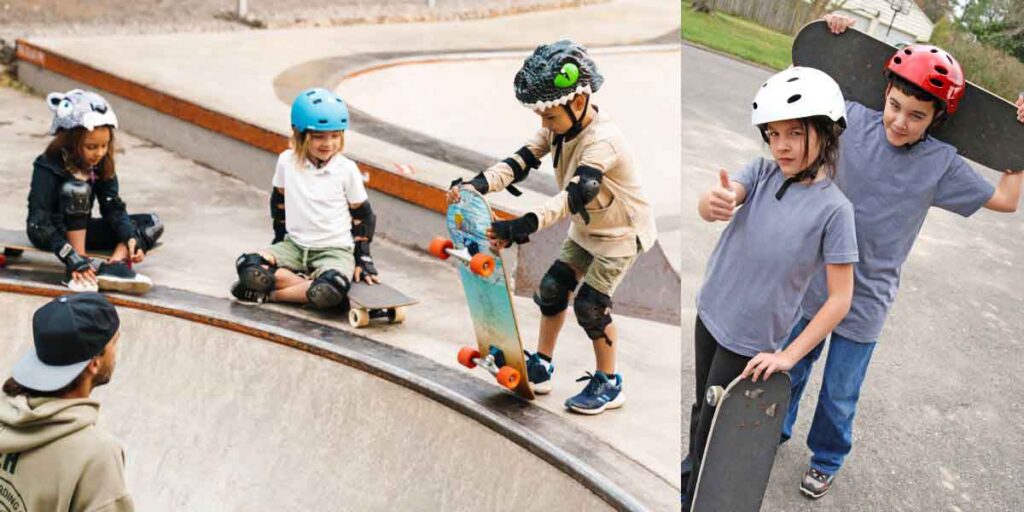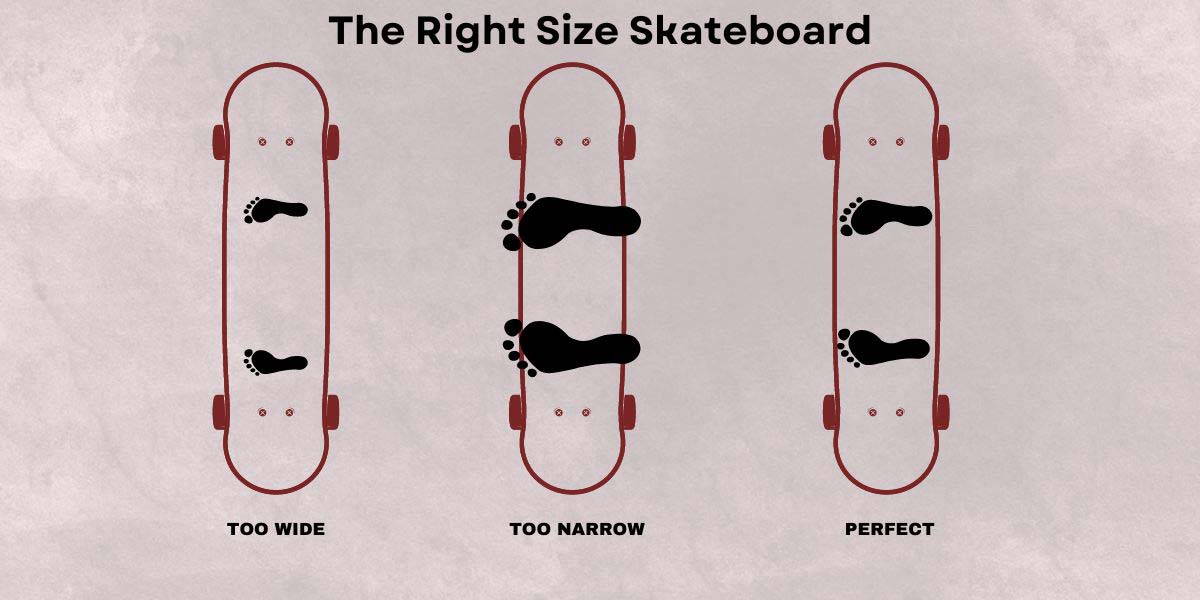Finding the right skateboard size is like unlocking the secret to a smoother, more controlled ride. Whether you’re new to skating or looking to level up your skills, choosing the right board size can make all the difference. From mastering your balance to nailing tricks, your skateboard’s size directly affects how you perform on the street, in the park, or at the skate ramp. The best skateboard size depends on your age, height, shoe size, and riding style, so it’s essential to consider all these factors when selecting a skateboard.
In this blog post, we’ll explore how to choose skateboard size and provide you with all the information you need to select the perfect board. Let’s get started!
Why Choosing the Right Skateboard Size Matters
Picking the right skateboard size is more than just a detail—it affects how comfortable, balanced, and safe you feel while skating. When your board fits you well, it’s easier to ride smoothly, learn new tricks, and stay in control. On the other hand, if your board is too big or too small, it can affect your performance and increase the risk of falls.
Skateboard Size Basics: Deck Width, Length, and Wheelbase
When choosing a skateboard, you’ll mainly focus on the deck’s width, length, and wheelbase. Here’s a quick breakdown:
Deck Width
The width of the skateboard deck is the most critical factor. It’s measured in inches and usually ranges from 7.5″ to 8.5″ or more. A wider deck offers more stability but can feel heavier, while a narrower deck is lighter and easier to flip. Your shoe size and style of skating will help determine what width of skateboard you should get:
- 7.5″ to 8.0″: Best for street skating and technical tricks.
- 8.0″ to 8.25″: Good all-around option for park and transition skating.
- 8.25″ and up: Great for vert ramps, cruising, or heavier riders who need more stability.
Deck Length
Length varies less than width, usually between 28″ and 33″. It affects stability and control, but is often less important than width.
Wheelbase
This is the distance between the front and back wheels. A longer wheelbase provides more stability. On the other hand, a shorter one allows for quicker turns.
These dimensions affect how the skateboard handles and feels under your feet. That’s why understanding these basics can help you make a more informed decision.
Understanding Skateboard Deck Shapes
- Popsicle Shape: Symmetrical nose and tail, ideal for street and park skating.
- Old School Shape: Wider nose and tail, often with a directional shape; great for cruising and pools.
- Cruiser Shape: Best for getting around town; typically features a wider deck and softer wheels.
- Longboard Shape: Designed for long-distance or downhill; longer than standard boards and very stable.
Perfect Skateboard Size Chart
Here’s a quick reference chart to help you find the right skateboard size based on your age, height, shoe size, and skill level. These charts will help you quickly identify the best size for your needs.
Skateboard Size by Age, Height, and Shoe Size
| Age Group | Height | Shoe Size (US) | Deck Width (inches) | Deck Category |
|---|---|---|---|---|
| 5 and under | Under 3’4″ (102 cm) | 0–3 | 6.5″ – 6.75″ | Micro |
| 6–8 years | 3’5″ – 4’4″ (104–132 cm) | 4–5 | 7.0″ | Mini |
| 9–12 years | 4’5″ – 5’2″ (134–157 cm) | 6–7 | 7.3″ | Small |
| 13–14 years | 5’3″ – 5’8″ (160–172 cm) | 7–8 | 7.5″ – 7.6″ | Mid |
| 15+ years | 5’7″ and up (170+ cm) | 9 and up | 7.7″ and up | Full |
Skateboard Size by Shoe Size
| US Men’s Shoe Size | Deck Width (inches) |
|---|---|
| 5 – 7 | 7.5″ – 7.75″ |
| 7.5 – 9 | 7.75″ – 8.25″ |
| 9.5 – 11 | 8.25″ – 8.5″ |
| 11.5 – 13 | 8.5″ – 8.75″ |
| 13 and above | 8.75″ – 9.0″ |
Skateboard Size by Riding Style
| Riding Style | Recommended Deck Width (inches) | Notes |
|---|---|---|
| Street/Technical | 7.5″ – 8.0″ | Ideal for flip tricks and technical maneuvers. |
| Park/All-Around | 8.0″ – 8.25″ | Versatile for various terrains. |
| Vert/Bowl | 8.25″ – 8.5″ | Provides stability on ramps and bowls. |
| Cruising/Commuting | 8.5″ – 9.0″ | Offers a smoother ride for commuting. |
| Downhill/Longboarding | 9.0″ and above | Ensures control at high speeds. |
How to Choose Skateboard Size for Different Age Groups

Kids (Ages 5-10)
For kids, control and ease of learning are essential. Choose a smaller board, usually between 6.5″ and 7.5″. These sizes are light enough for kids to maneuver and offer enough stability to help them learn the basics without feeling overwhelmed.
Additional Tips for Kids:
- Look for boards specifically labeled for kids, often marked as “mini” or “micro.”
- Ensure the board has softer skateboard wheels to reduce the impact of rough surfaces.
Teens (Ages 11-17)
Teen skaters often develop rapidly, so they need a size that balances performance and growth. Boards between 7.5″ and 8.0″ are ideal. This size range allows teens to try different tricks while still providing enough stability as they grow.
Extra Considerations:
- Teens should look for boards that suit their riding style—wider for ramps and vert skating, narrower for street tricks.
- A medium concave deck shape is often preferred, giving a good mix of control and comfort.
Adults (18+)
Adults have more flexibility when choosing skateboard sizes. An 8.0″ to 8.5″ board is usually perfect for most adults, whether you’re into tricks, cruising, or park riding. Larger sizes provide stability, while slightly narrower boards make flips and street tricks easier.
Special Note for Adult Riders:
- Consider your weight, as heavier riders might prefer slightly wider decks for better support.
- If you’re primarily using your board for commuting or long-distance rides, look for longer decks with a wider wheelbase for enhanced stability.
Step-by-Step Guide: How to Choose the Right Skateboard Size

Step 1: Measure Your Height and Shoe Size
Start by measuring your height and checking your shoe size. These measurements will help you match with the size chart, giving you a solid starting point for picking your board.
Shorter Riders (< 5’6”): Opt for a narrower board around 7.5” to 8.0”.
Taller Riders (> 5’6”): Go for an 8.0” to 8.5” board to maintain better balance.
Step 2: Determine Your Riding Style (Street, Park, Vert, Cruising)
Your riding style significantly impacts the ideal size:
Street Skating: Opt for a narrower board (7.5″ to 8.0″) for easier flips and technical tricks.
Park/Vert Skating: Wider boards (8.0″ and above) offer better control on ramps and bowls.
Cruising: Choose a wider board for extra stability while cruising around town.
Step 3: Test the Deck Width for Balance and Comfort
Testing different deck widths can help you find what feels best. Head to a local skate shop, stand on various sizes and see which one feels the most balanced. You want a size that offers enough room for your feet without feeling too heavy. You can also try a few basic movements like turning or jumping slightly, to see how the board reacts.
Step 4: Consider Deck Length and Wheelbase for Stability
Longer decks and wheelbases provide more stability, especially for taller or heavier skaters. If you’re a beginner, focus more on width, but keep an eye on length to ensure the board feels comfortable.
Special Considerations: Choosing a Skateboard Size for Kids

Safety and comfort are top priorities for kids. Smaller decks make it easier for young skaters to maintain control and learn the basics. As a parent, look for boards specifically labeled for kids, with softer wheels that help reduce falls on rough surfaces. Make sure the board isn’t too heavy for your child to lift and carry.
Common Mistakes When Choosing a Skateboard Size and How to Avoid Them
- A cool design doesn’t mean the board is the right size. Focus on finding the right fit for your needs instead of just the board’s appearance.
- New skaters, especially kids, should avoid large boards that are hard to control. Start with a smaller board and switch to a larger one as your skills improve.
- Your riding style affects the board size you need. Don’t pick a board just because a friend has it. Choose one that fits your specific skating style.
- If you can, test the board size at a skate shop to make sure it feels comfortable and right for you.
Conclusion
Choosing the right skateboard size can make all the difference in your skating experience. Follow this guide, use the size chart, and test boards to find your ideal fit. The right size will boost your confidence, improve your skills, and make every ride more enjoyable.
Ready to pick your perfect skateboard? Check out our detailed guides on beginner tricks and safety gear to get started!
FAQs on Skateboard Sizing
What size skateboard should a beginner use?
Beginners should start with a board width of 7.5″ to 8.0″, providing a good balance between control and maneuverability.
Is a wider skateboard better for stability?
Yes, wider boards offer more stability, making them ideal for cruising, vert skating, or beginners looking for extra control.
Can kids use adult-sized skateboards?
It’s not recommended. Adult-sized boards can be too heavy and difficult for kids to control, which may hinder their learning.
How do I know if my skateboard is the wrong size?
If you’re struggling to maintain balance, feel unstable, or have difficulty controlling the board, it could be the wrong size for you.
How do I measure skateboard width?
Measure the skateboard’s width at its widest point. Use a ruler or tape measure for accurate dimensions.
How long is a skateboard?
The length of a skateboard typically ranges from 28 to 33 inches (71 to 84 cm). Standard street and park skateboards are usually around 31 to 32 inches (79 to 81 cm) long. However, longboards and cruisers can be longer, often exceeding 40 inches (102 cm). The ideal length depends on the rider’s preference and intended use.
What width skateboard should I get if I wear size 10 shoes?
Go for at least an 8.0″ deck to ensure a comfortable fit.
How to measure skateboard size?
Use a measuring tape to check deck width at the widest point. Length can be measured from nose to tail.
What size skate deck should I get for cruising?
Choose an 8.25″+ width with a longer wheelbase for better stability.
How to know what size skateboard to get based on my height?
Under 5’6″? Try 7.5″ to 8.0″. Over 5’6″? Go with 8.0″ to 8.5″.
What are the standard skateboard dimensions for street skating?
Most street skaters use boards between 7.75″ and 8.0″ in width and about 31–32″ in length.

